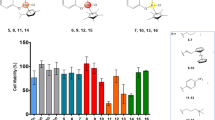Abstract
In our attempt to define the parameters affecting anticancer activity of titanium complexes and to assess the role of hydrolytic stability, titanium compounds of oxygen-based ligands were studied. A homoleptic complex of hydroxyamino-1,3,5-triazine ligands was prepared and its hydrolysis was investigated by UV–vis spectroscopy at biologically relevant pH and temperature conditions based on its ligand to metal charge transfer absorption band. This complex exhibits very high hydrolytic stability under the conditions measured with negligible ligand dissociation. Its anticancer reactivity was investigated on ovarian OVCAR-1 and colon HT-29 cells, in comparison with the reference highly labile Ti(OiPr)4 and TiCl4(THF)2 (where THF is tetrahydrofuran), the inert thermodynamically stable TiO2, and the free aromatic hydroxyamino-1,3,5-triazine ligand. Whereas all reference titanium complexes were found to be completely unreactive against both tumor cell types, suggesting some moderate inertness is required, the homoleptic complex of the triazine ligands clearly possess some mild reactivity despite having no labile groups, and despite its incomplete solubility in the concentrations applied. As the free aromatic ligand is highly active under similar conditions, detailed time-dependence measurements were conducted and indicated that the cytotoxicity of the ligand is more affected by reducing incubation time, and that introducing the titanium complex to the medium prior to cell administration does not increase reactivity at a certain incubation time. These findings suggest that the reactivity of the complex does not result from that of the free ligand following dissociation, but rather involves the titanium center.







Similar content being viewed by others
Notes
The organic solvent, THF or acetone (50% v/v), was employed both to provide a reference (prior to water addition) and to allow accurate monitoring of absorbance change, as well as to enhance solubility. Ti(L1)2 exhibits very mild solubility in pure water solutions and in solutions with greater water to organic solvent ratio.
Unpublished results indicate that a structurally similar homoleptic mer [ONO]2Ti type complex of amine bis(phenolate) ligands hydrolyzes within seconds, emphasizing the large effect of the electron-rich nature of the dative N atoms in Ti(L1)2.
Even upon addition of significant volumes of water to an acetone solution of Ti(L1)2 to give, for example, a 90% v/v water solution, the yellow precipitation observed was verified by NMR to be unchanged Ti(L1)2.
References
Wong E, Giandomenico CM (1999) Chem Rev 99:2451–2466
Clarke MJ, Zhu F, Frasca DR (1999) Chem Rev 99:2511–2533
Kratz F, Schütte MT (1998) Cancer J 11:176–182
Köpf-Maier P (1994) Eur J Clin Pharmacol 47:1–16
Köpf-Maier P, Köpf H (1987) Chem Rev 87:1137–1152
Meléndez E (2002) Crit Rev Oncol Hemat 42:309–315
Caruso F, Rossi M, Pettinari C (2001) Expert Opin Ther Pat 11:969–979
Köpf-Maier P, Köpf H (1988) Struct Bonding 70:103–185
Kelter G, Sweeney NJ, Strohfeldt K, Fiebig HH, Tacke M (2005) Anticancer Drugs 16:1091–1098
Christodoulou CV, Eliopoulos AG, Young LS, Hodgkins L, Ferry DR, Kerr DJ (1998) Br J Cancer 77:2088–2097
Keppler BK, Friesen C, Moritz HG, Vongerichten H, Vogel E (1991) Struct Bonding 78:97–127
Caruso F, Rossi M, Tanski J, Sartori R, Sariego R, Moya S, Diez S, Navarrete E, Cingolani A, Marchetti F, Pettinari C (2000) J Med Chem 43:3665–3670
Toney JH, Marks TJ (1985) J Am Chem Soc 107:947–953
Krüger N, Kleeberg UR, Mross K, Edler L, Saß G, Hossfeld DK (2000) Onkologie 23:60–62
Yang P, Guo M (1999) Coord Chem Rev 185–186:189–211
Caruso F, Rossi M, Opazo C, Pettinari C (2005) Bioinorg Chem Appl 3:317–329
Li HY, Qian ZM (2002) Med Res Rev 22:225–250
Sun HZ, Li HY, Weir RA, Sadler PJ (1998) Angew Chem Int Ed Engl 37:1577–1579
Guo ML, Sadler PJ (2000) J Chem Soc Dalton Trans 7–9
Guo ML, Sun H, Bihari S, Parkinson JA, Gould RO, Parsons S, Sadler PJ (2000) Inorg Chem 39:206–215
Guo ML, Sun H, McArdle HJ, Gambling L, Sadler PJ (2000) Biochemistry 39:10023–10033
Köpf-Maier P (1999) Anticancer Res 19:493–504
Peri D, Alexander J, Tshuva EY, Melman A (2006) Dalton Trans 4169–4172
Ravera M, Cassino C, Monti E, Gariboldi M, Osella D (2005) J Inorg Biochem 99:2264–2269
Alley MC, Scudiero DA, Monks A, Hursey ML, Czerwinski MJ, Fine DL, Abbott BJ, Mayo JG, Shoemaker RH, Boyd MR (1988) Cancer Res 48:589–601
Mokdsi G, Harding MM (1998) J Organomet Chem 565:29–35
Pérez Y, López V, Rivera-Rivera L, Cardona A, Meléndez E (2005) J Biol Inorg Chem 10:94–104
Mokdsi G, Harding MM (1998) Met Based Drugs 5:207–215
Tacke M, Allen LT, Cuffe L, Gallagher WM, Lou Y, Mendoza O, Müller-Bunz H, Rehmann FJK, Sweeney N (2004) J Organomet Chem 689:2242–2249
Acknowledgements
We thank the Allon Foundation as well as the friends of the Hebrew University USA for financial support. We also thank Claudia M. Barzilay and Natalya Cogan from the School of Pharmacy for assistance with biological procedures and fruitful discussions.
Author information
Authors and Affiliations
Corresponding author
Rights and permissions
About this article
Cite this article
Shavit, M., Peri, D., Melman, A. et al. Antitumor reactivity of non-metallocene titanium complexes of oxygen-based ligands: is ligand lability essential?. J Biol Inorg Chem 12, 825–830 (2007). https://doi.org/10.1007/s00775-007-0236-8
Received:
Accepted:
Published:
Issue Date:
DOI: https://doi.org/10.1007/s00775-007-0236-8




